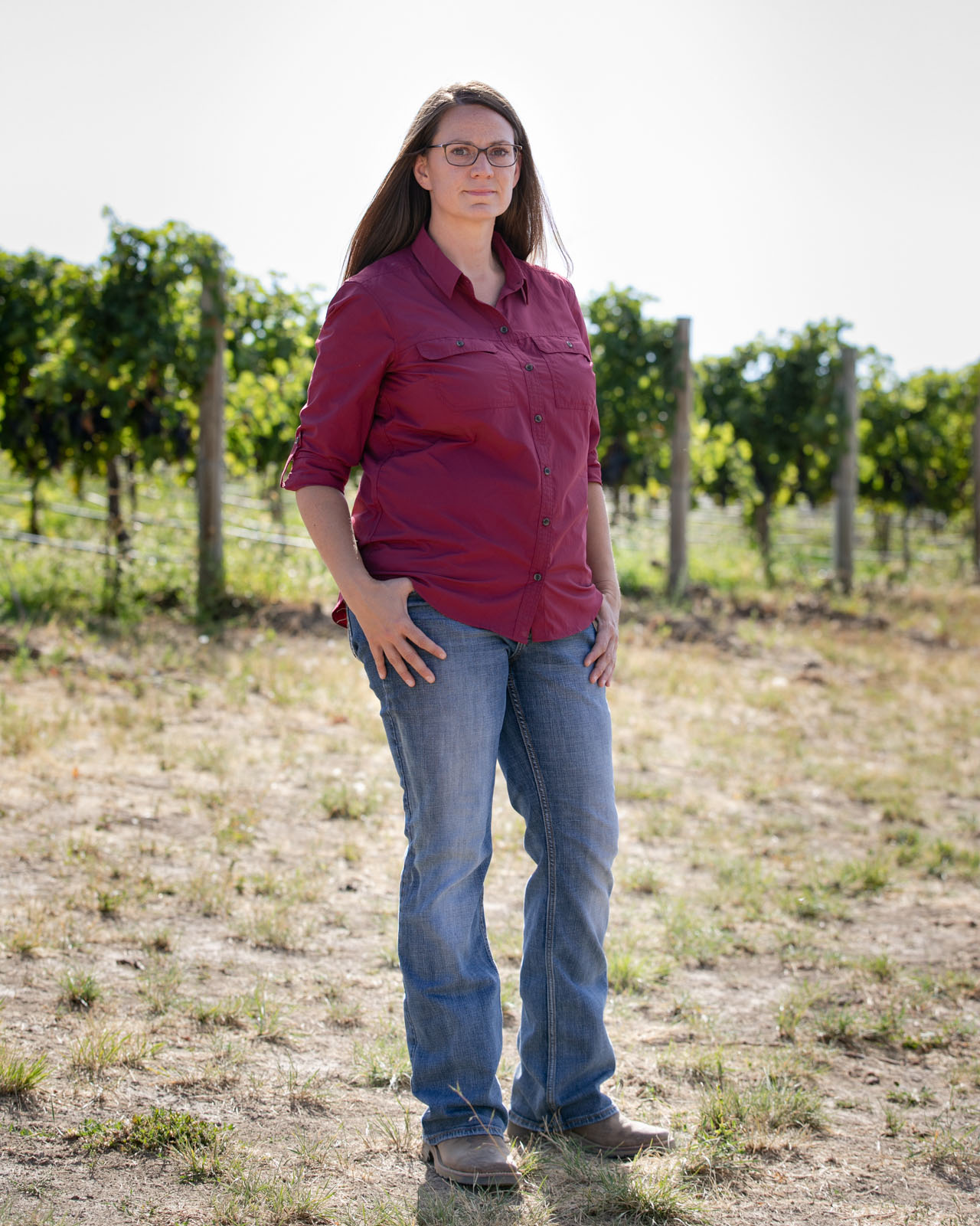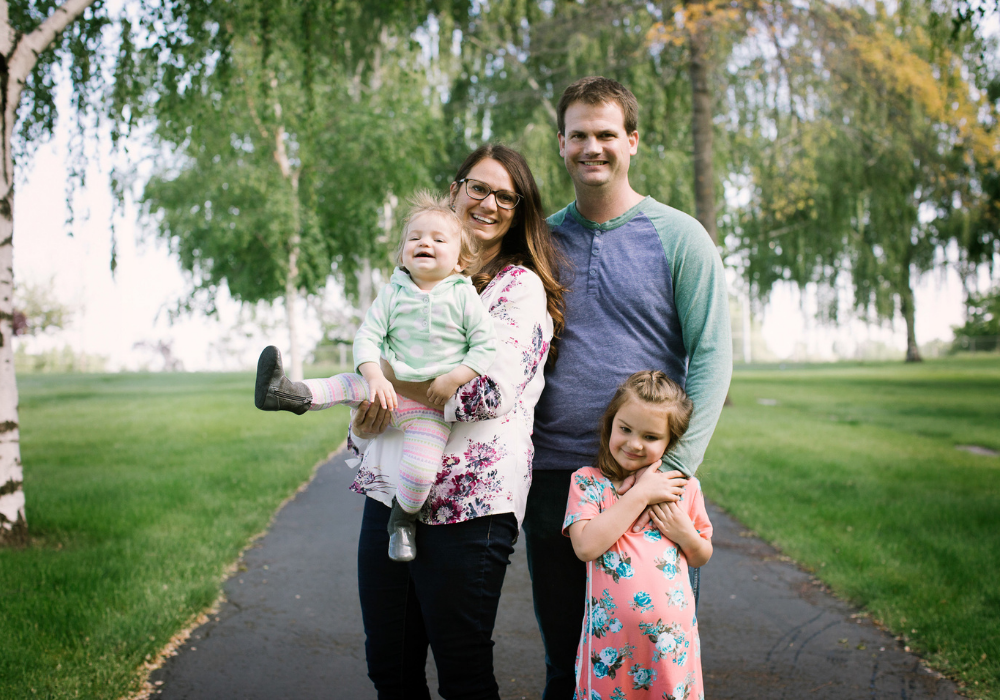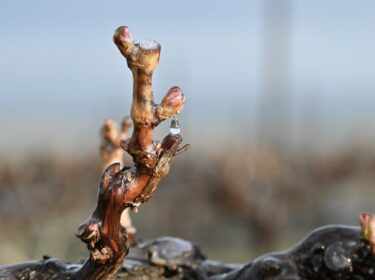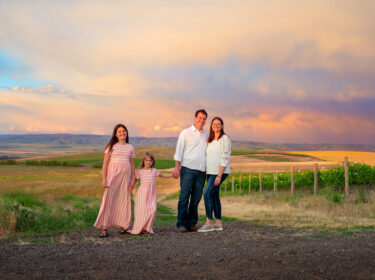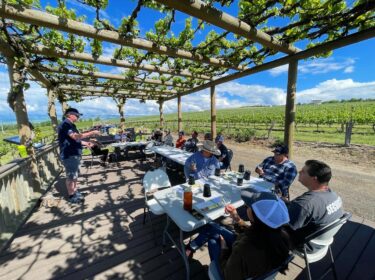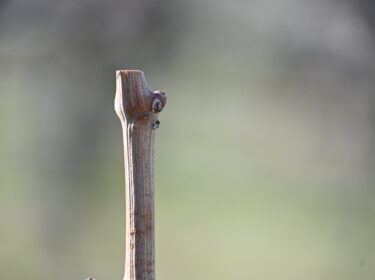“Haremos haciendo alrededor de 250 selecciones separadas.”
Meet Sadie Drury, General Manager at North Slope Management, where she oversees 50 crew members and 300 acres of vines in the SeVein area of the Walla Walla Valley. “I’ve always been working outdoors. I don’t know that farming’s the right word,” Sadie told us during our interview together, “but I’ve worked on ranches. I’ve worked on horse ranches, cattle ranches. I worked pea harvests. My first job when I was 12 was picking strawberries. It’s a rite of passage in Walla Walla to pick strawberries when you’re 12 years old.” Sadie picks a lot more now than just strawberries, as they have almost 250 picks during each harvest.
I always wanted to be outside. I always wanted to work with my hands.—Sadie Drury, North Slope Management
Traducido por Laurita Angulo
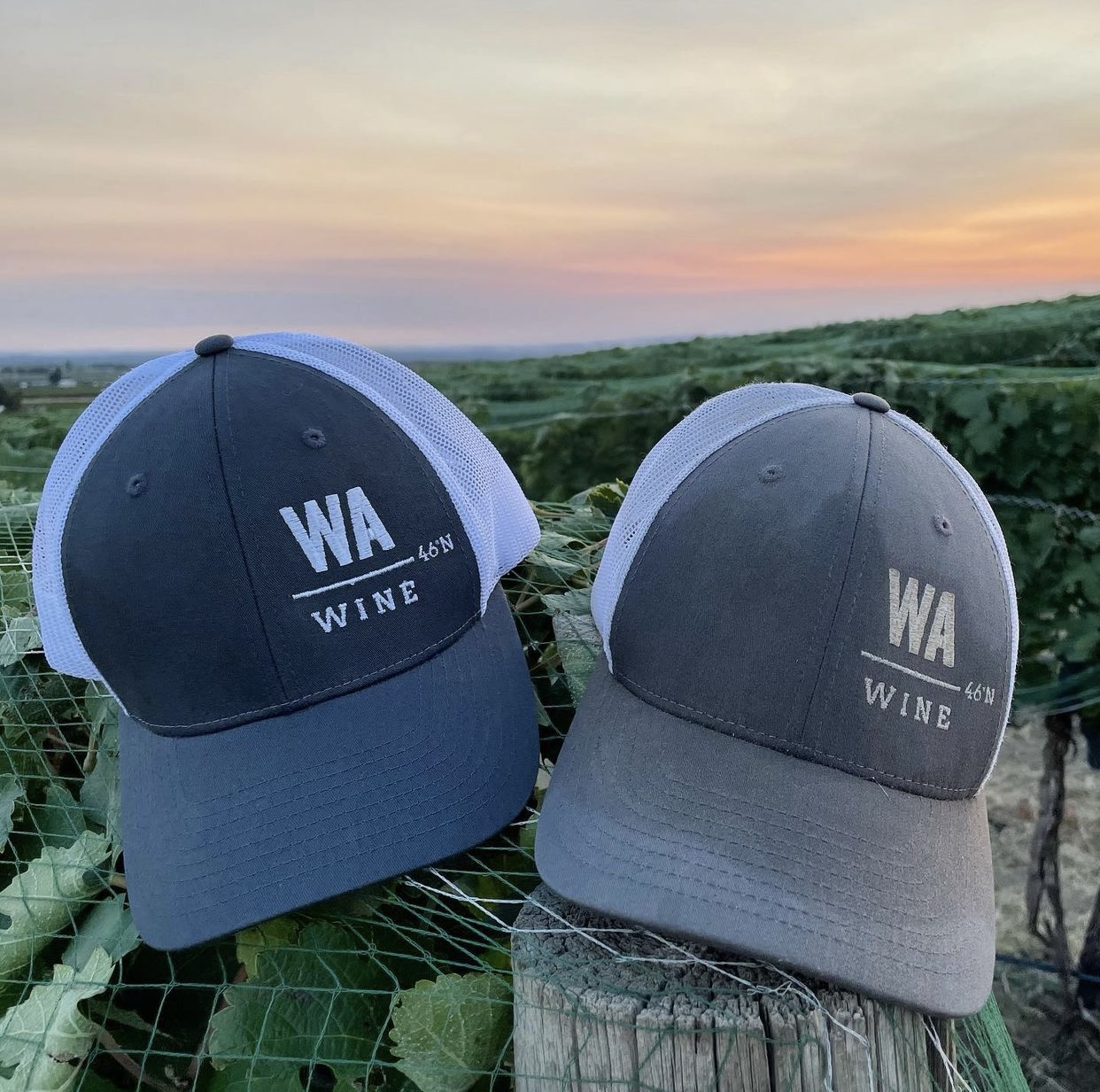
Washington Wine: Sumerjámonos y veamos lo superficial primero: ¿dónde se encuentra, cuál es su título y cuál es la vista general de 30,000 pies?
Sadie Drury: Soy gerente general de una empresa de gestión agrícola llamada North Slope Management. Cultivamos alrededor de 300 acres de uvas en Walla Walla AVA. Como gerente general, realmente solo administro un equipo grande de personas que hacen el trabajo. Coordino las ventas de uva y las actividades del día a día en el viñedo.
WW: ¿Qué tan similar o diferente, es ser un GG versus ser un gerente de viñedos?
SD : Creo que somos únicos porque la forma en que estructuramos las cosas es que soy gerente de viñedo, pero también viticultora porque hago mucha coordinación.
Al tener mejor posicion, me apoyo más en las personas para que me ayuden a tomar decisiones. Un viticultor podría estar simplemente explorando y rociando, y un gerente de viñedos podría estar manejando a la gente y trabajando con los enólogos, pero tengo esta cosa híbrida en la que trabajo con los enólogos de manera bastante exclusiva, pero generalmente me apoyo en mi mayordomo y mis supervisores en gran medida para que administren a las personas por mí. Trato de no involucrarme demasiado a menos que me necesiten. Y luego, siendo también la viticultora, escribo todas las recomendaciones de riego y aspersión, pero me apoyo mucho en mis tecnicos de viticultura y mis pasantes para que me ayuden a explorar. Puede ser exclusivo de esta empresa, porque solo tenemos 300 acres. Creo que si fuéramos más grandes, tendría que ser solo una cosa o la otra, pero somos lo suficientemente pequeños que podemos hacer mucho.
Trabajo para North Slope Management, lo que también significa que soy contratista de mano de obra agrícola. Puedo llevar a mi tripulación e ir a trabajar a cualquier parte.
WW: ¿En qué viñedos trabajas?
SD : Trabajamos exclusivamente en el área de SeVein, por lo que nunca tenemos que mover equipo. No tenemos que poner cosas en remolques y conducirlos por la ciudad. No es que no pudiera. Podría ir a trabajar a más lugares, simplemente elegimos no hacerlo. Esto jala a los empleados. Todos mis empleados conducirán al trabajo y trabajarán desde la misma base de operacion todos los días.
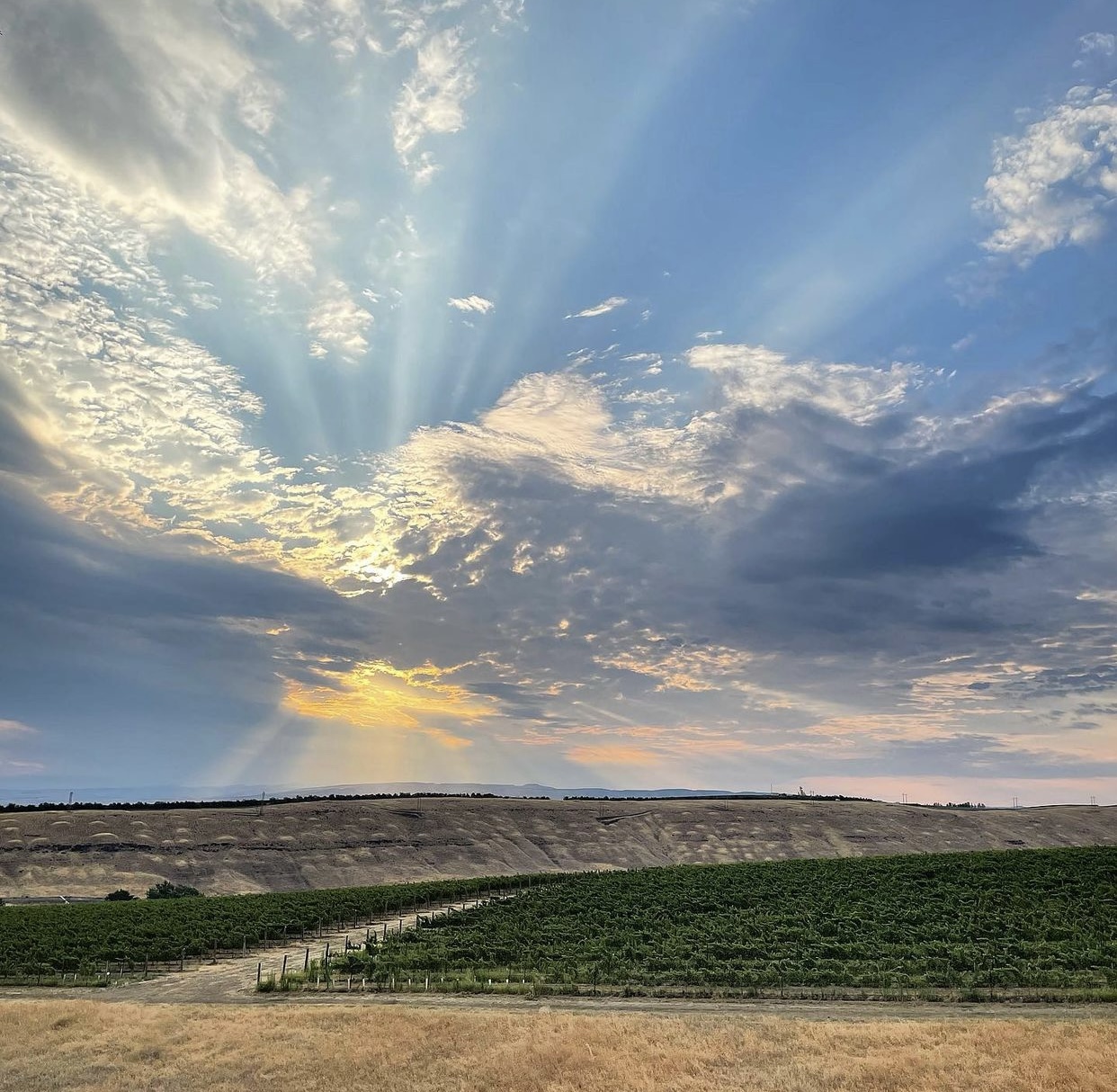
WW: Entonces administras 300 acres. ¿Qué significa eso, en términos de escala o alcance?
SD : Vendemos uva a 55 bodegas diferentes cada año. La mayoría de todas las ventas provienen de Seven Hills Vineyard, y luego los otros seis viñedos son los que cultivamos a medida para la fruta de la finca.
Cultivamos un viñedo para L’Ecole y todo se envía a L’Ecole. Lo hacemos para JM Cellars y para Pambrum Winery. Tenemos estos diferentes clientes para los que cultivamos a medida, pero Seven Hills Vineyard es donde se envían las uvas a múltiples bodegas. Y en realidad eso se traduce en mucho caos organizado. Porque haremos — creo que conté durante la cosecha — haciendo alrededor de 250 selecciones separadas. Seleccionamos medio acre aquí y luego recogemos un cuarto de acre allí y luego recogemos un acre aquí, todo para diferentes clientes.
Hacemos todas estas selecciones diferentes, y tenemos que hacer un seguimiento de todos los contenedores y todas las personas y todos los lugares y asegurarnos de que la fruta correcta llegue a los camiones correctos. No creo que 300 acres es gran cantidad hasta que empiezas a dividir en pequeños pedazos. La parte de la agricultura personalizada es donde se complica. Por ejemplo, tengo el Bloque 14, que son uvas Cabernet. Son siete acres y tenemos 12 clientes diferentes en ese bloque. Un cliente quiere dos toneladas por acre, y el cliente a su lado puede querer cuatro, y algunos quieren que les arranquen las hojas mientras que otros no. Es un montón de pequeñas piezas que tienes que juntar.
WW: Estoy obteniendo una imagen tuya como Tom Cruise en Sentencia Previa.
SD : No he visto eso en 15 años.
WW: Lo mismo. Continuemos: ¿cómo llegaste hasta aquí? ¿Cómo fue tu recorrido? ¿Estuviste siempre en la agricultura y en las uvas y en el vino? ¿O fue un gran giro en algún momento?
SD : Siempre he trabajado al aire libre. No sé si agricultura es la palabra correcta, pero he trabajado en ranchos. He trabajado en ranchos de caballos, ranchos de ganado. Trabajé la cosecha de chicharo. Mi primer trabajo cuando tenía 12 años fue recogiendo fresas. Es un rito de iniciación en Walla Walla recoger fresas cuando tienes 12 años.
Siempre quise estar afuera. Siempre quise trabajar con mis manos. Después de la secundaria, fui a la Universidad de Walla Walla durante un trimestre en la que decidi: “Me voy. No estoy destinada a sentarme en un salón de clase. Esto no es para mí”. Así que viajé. Viví en Texas, Las Vegas y en Idaho y eventualmente regresé a Walla Walla. Estaba entrenando caballos en Walla Walla, pero en realidad, era camarera. Trabajaba toda la noche para ganar dinero y luego montaba caballos todo el día porque nadie gana dinero montando caballos.
La escena del vino había explotado desde el momento en que me gradué de la escuela secundaria hasta el momento en que regresé. Pasamos de 30 bodegas en 2001 a cerca de 100 en 2007. Hubo un gran estallido en ese momento y yo quería ser parte de él. No necesariamente quería estar en la bodega. Lo supe desde el principio, solo quería cultivar uvas. Tuve una cita con un enólogo y me llevó a un viñedo y me dije a mi misma: “Esto es. Voy a cultivar uvas”.
Y eso es lo que pasó. Comencé la escuela en 2007, fui al Community College durante dos años y obtuve una pasantía. Terminé quedándome allí, en Ciel du Cheval durante cinco años trabajando para Jim Holmes y termine en Walla Walla a principios de 2013.
Siempre quise estar afuera. Siempre quise trabajar con mis manos. No estoy destinada a sentarme en un salón de clase.
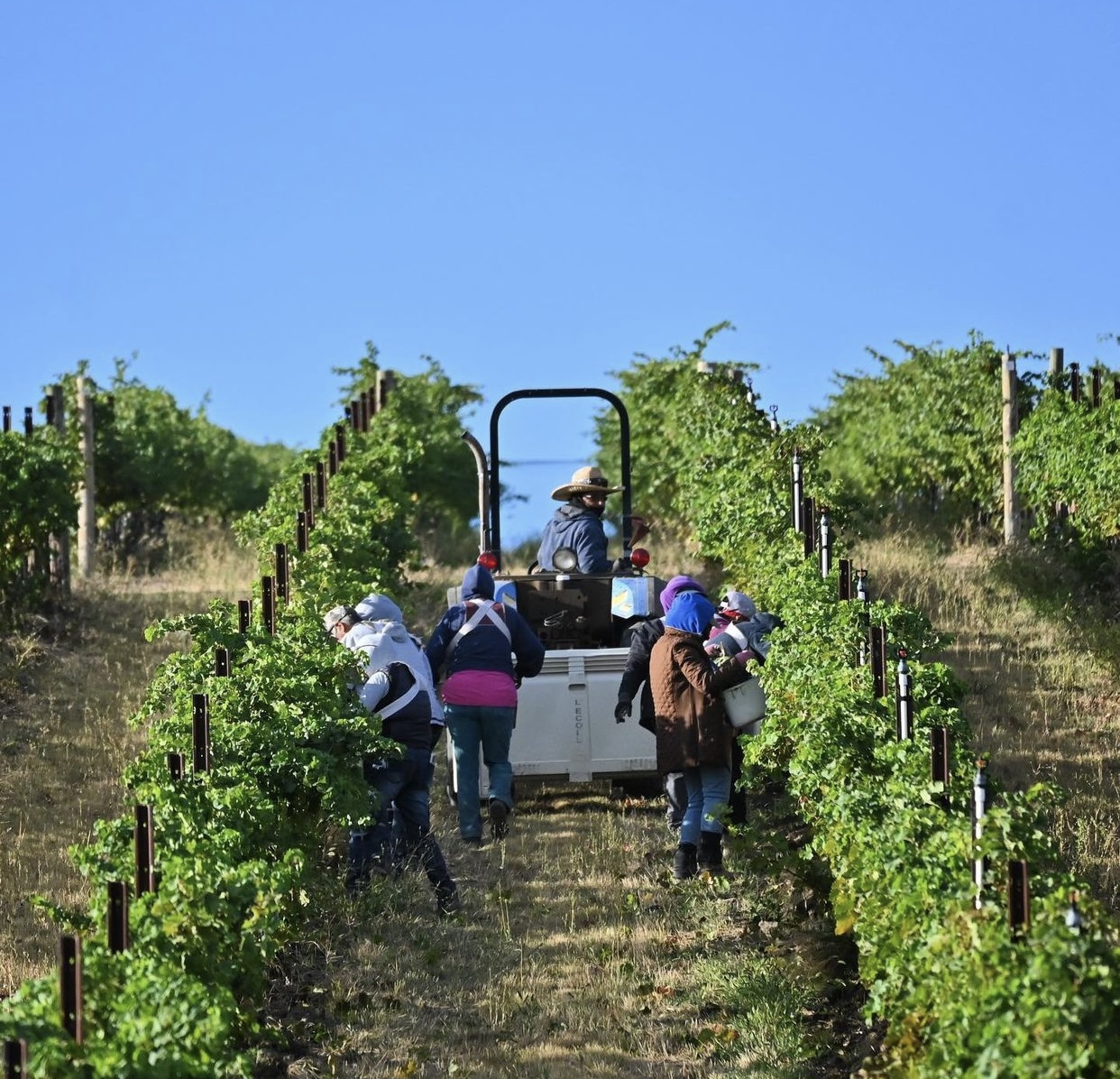
WW: Me encanta. Entonces, ¿cuántas personas forman parte de su tripulación? ¿Cuántas tripulaciones tienes? ¿Cómo es toda esa operación que manejas a diario y semanalmente?
SD : Tengo unos 50 empleados. Dependiendo de la semana, podría ser 40, y luego aumentamos a los 50 que es el punto máximo.
WW: Para cuando salga esta publicación, sé que habrá cambiado, pero ¿dónde estamos ahora en el año de la cosecha?
SD : En envero, es tan hermoso. No diría que es mi época favorita del año, pero definitivamente está entre las tres mejores. Es bastante impresionante ver todo cambiar de color. ¿Qué tengo en mente ahora mismo? Va a ser una cosecha ligera, por lo que normalmente estaríamos raleando la cosecha en este momento, pero en realidad no hay nada que ralear. Vamos a estar trabajando en algunos otros proyectos. Estamos trabajando en unos viñedos jóvenes, estamos atando y entrenando, recogiendo los brotes que queremos atar al alambre, para que haya futuros cordones.
WW: ¿Qué significa eso exactamente?
SD : Cuando plantamos las uvas, es solo un pequeño palo en la tierra. Y no hay mucho que sobresalga del suelo. De ese palito crecerán dos largos brotes hacia el cielo. Pasamos unos dos años desarrollando esos dos brotes. Y cuando las plantas tienen dos años, que son ahora, las tomamos y las ponemos en el cordón de alambre. Así que siempre piensas en cómo crece una planta hacia arriba y hacia afuera. Eso requiere una buena cantidad de entrenamiento. Elegimos qué brotes están bien, hermosos y fuertes, y luego los colocamos y los pegamos con cinta adhesiva al alambre. Y luego, con suerte, esa parte de la planta estará allí durante los próximos 50 años, mientras que esté dentro de la tierra.
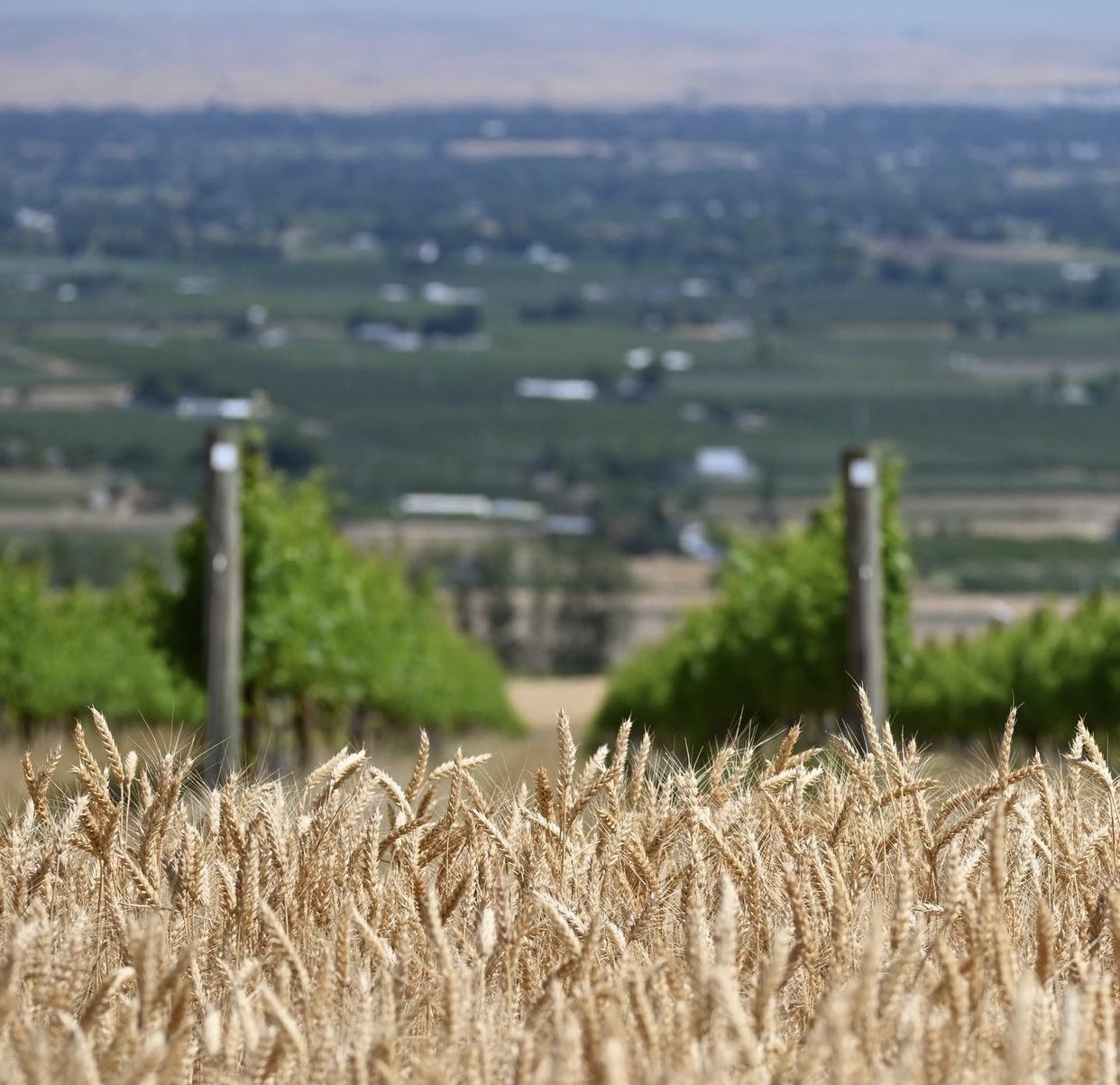
WW: ¿Qué tanto tiempo require de ti la cosecha?
SD : Requiere bastante, pero en el buen sentido. Podríamos trabajar más horas durante la cosecha que en cualquier otra época del año. Pero lo mejor de la cosecha es que, cuando llega la cosecha, solo hay un trabajo el cual es de recoger las uvas. Que el personal recoja las uvas correctas, las coloque en los contenedores correctos, y en el camión correcto para la bodega correcta.
Es mucho, pero en realidad es mucho más fácil y menos agotador emocionalmente que cuando es abril o mayo y estamos cortando brotes, rociando, regando, tratando de mantener nuestros tractores funcionando y deshierbando. La tripulación podría estar haciendo tres trabajos diferentes. Así que la cosecha consume todo, pero es la luz al final del túnel y un soplo de aire fresco en comparación con lo sobreexigidos que estamos a través de todos los otros trabajos durante el resto del año.
La otra gran cosa acerca de la cosecha es que no hay juntas. No tengo que preocuparme por los presupuestos durante la cosecha porque nadie está pensando en eso. Acabamos de terminar todos nuestros préstamos bancarios anuales y es sorprendente el tiempo que se lleva para hacer todos los presupuestos y de asegurar de enviar todo al banco. Y ese es mi trabajo porque soy la única persona aquí que vigila las finanzas. Así que me gusta la cosecha. No me gusta levantarme a las tres de la mañana para empezar a recoger uvas, pero me encanta que solo haya un trabajo.
La otra gran cosa acerca de la cosecha es que no hay juntas. No tengo que preocuparme por los presupuestos.
WW: ¿Cómo es la colaboración con las bodegas? Con 50 bodegas o clientes, ¿puedes ser selectivo en cuanto para quién cultivas uvas?
SD : Llegamos a ser selectivos. Lo que me encanta es que este es mi noveno año de cosecha, y durante los últimos nueve años, el viñedo ha tenido una buena reputación. Empecé con un lugar que tenía una buena reputación.
He crecido esa reputación aún más. He desarrollado la confianza con mis clientes y tengo muy buena relación con ellos. Me toca trabajar con personas realmente buenas que confían que hare un buen trabajo, y no soy microgestionado y eso es increíble. Pero el otro lado de eso es que, como nuestro viñedo tiene buena reputación, no trabajo con gente que hace vino malo. No trabajo con personas que no pagan sus cuentas. Pienso que soy selective y trabajo con personas que son realmente geniales que sé que van a hacer un gran vino de mis viñedos y pagarán sus facturas y serán enólogos responsables. Me siento súper afortunada de esa manera, que puedo ser selectiva. Y creo que ese es siempre el objetivo de probablemente cualquier viñedo o cualquier bodega, llegar al lugar en el que estamos ahora. Es una buena sensación. Trabajo en un lugar donde los enólogos quieren poner el nombre del viñedo en la etiqueta.
Trabajo en un lugar donde los enólogos quieren poner el nombre del viñedo en la etiqueta.
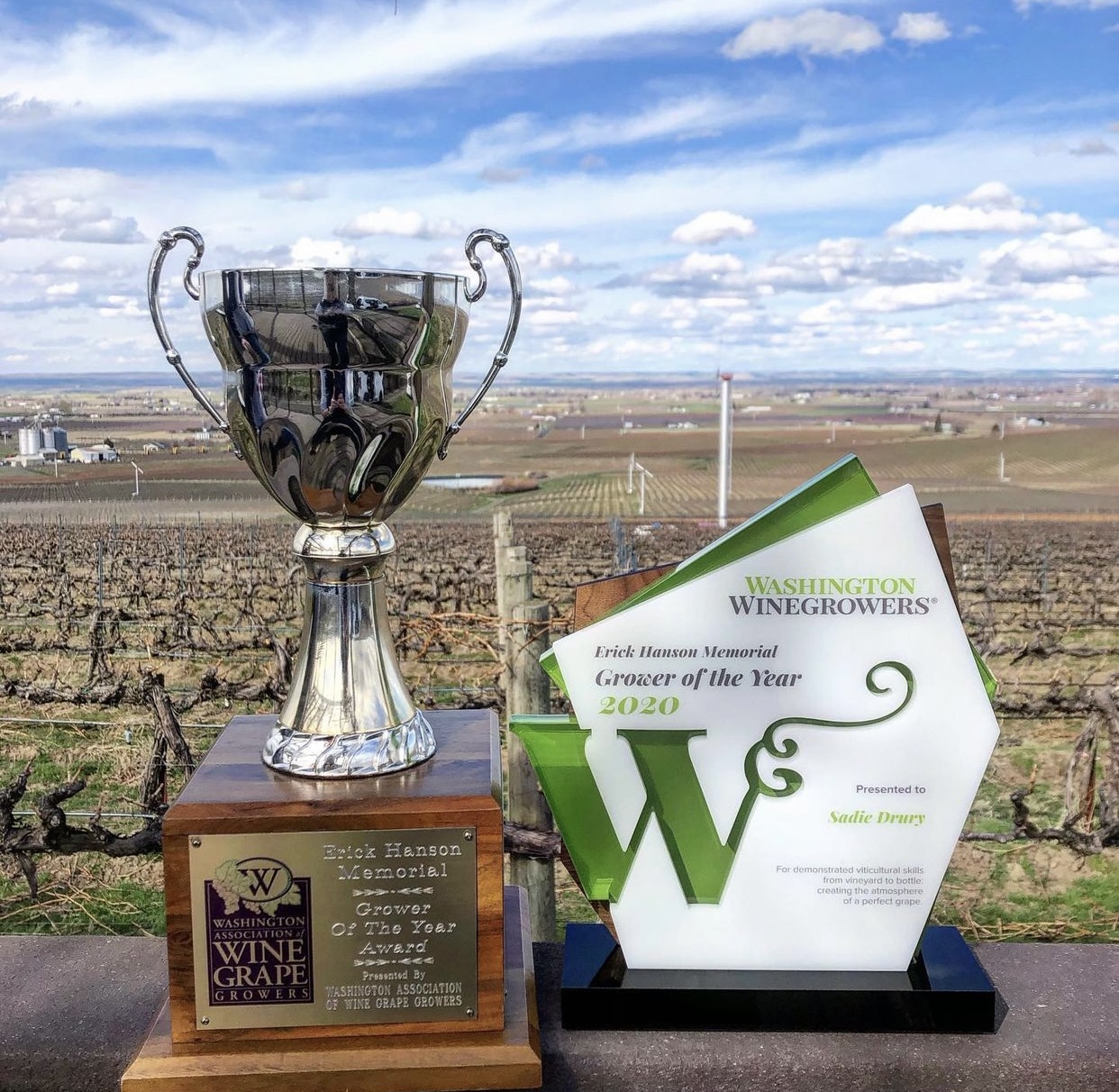
WW: Hablando de eso, fuiste nombrada Viticultora del Año en 2020. ¿Qué se siente al recibir ese reconocimiento?
SD : Cuando obtuve el premio de Productora del Año, fue interesante porque no estaba frente a una multitud. No pude dar las gracias a la gente. Y tuve un momento para pensar: “No me merezco esto. Solo organizo a las personas que hacen el trabajo”. Y realmente quería encontrar una manera de decir gracias y mostrar cuán increíble es mi equipo porque sin ellos, no puedo ser la Productora del Año. No consigo tener buenas uvas. No consigo tener buenas relaciones con mis clientes, ni estar en la comisión de vinos ni ninguna de estas cosas. Mi equipo es el que hace esto. Lo hacen posible porque confían en mí, confían en mí y quieren trabajar para mí y confían en que los cuidaré. Y creo que les pago bien.
Quería encontrar una manera de mostrar eso. Así que se me ocurrió la idea de reconocer a un empleado diferente cada viernes. Y comenzamos con Lupe porque él es el empleado de mayor rango, pero también porque si puedo convencer a Lupe de estar de acuerdo en algo, puedo convencer a otras personas tambien a que esten de acuerdo con lo mismo. Mi equipo está acostumbrado a que les tome fotos, pero no les gusta. Quieren estar en grupos para poder taparse la cara o algo asi. Y no los culpo. No sé lo suficiente sobre sus vidas personales para saber si hay una razón para eso.
Cuando comenzamos a hacer esta serie Farmer Friday en mi Instagram, noté que mis empleados empezaban a seguirme en Instagram. Tambien empezaban a mandarme solicitudes de amistad en Facebook. Fue muy lindo. Y hasta ahora, todos están súper emocionados cuando llego a ellos y quieren que les tomen una foto. Quieren mostrar su cara. Quieren su nombre completo en las redes sociales. Y creo que realmente lo están viendo como una forma en la que les estoy agradeciendo y no solo diciendo: “Oye, mira quién trabaja para mí”, sino que estoy contando su historia. Y les encanta hacerlo con sus cónyuges o hermanos o padre, hijo, o lo que sea. Y todos han estado súper emocionados, incluida una mujer que nunca queria que le tomaran foto. Ni siquiera salia en fotos de grupo, pero ahora le ha estado preguntando al supervisor cuándo le toca su turno.
Ha sido una experiencia buena. Ha sido súper divertedo. Y luego llego a conocer más a la gente y eso también es divertido.
WW: Algunas preguntas finales. ¿Qué ocupa tu tiempo fuera del trabajo y el vino?
SD: Mi familia no es un hobby, pero son mi vida fuera del vino. Y caballos. Monto caballos todavía. Son bastante divertidos. Y amo la música en vivo, amo la música en vivo.
WW: Pregunta final: ¿cuál es tu sonido favorito (o tres) no musicales?
SD : ¿Qué suena musical?
WW: No musical.
SD : Oh, una tormenta.
WW: Guau, agradable.
SD : El primero de la lista. Me encantan los sonidos que se escuchan en las montañas. El arroyo y pájaros y todo eso es un sonido maravilloso. Y simplemente el sonido del silencio. O un bosque silencioso, aunque hay muchos sonidos allí. Y mis hijos riéndose. Podría estar teniendo un mal día y mi hijo de cuatro años puede estar riéndose de algo y simplemente cambiará todo.
WW: La mejor nota para terminar: la risa.
My familia no es un hobby, pero son mi vida fuera del vino.—Sadie Drury
